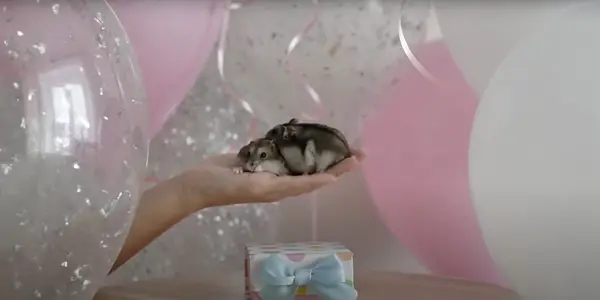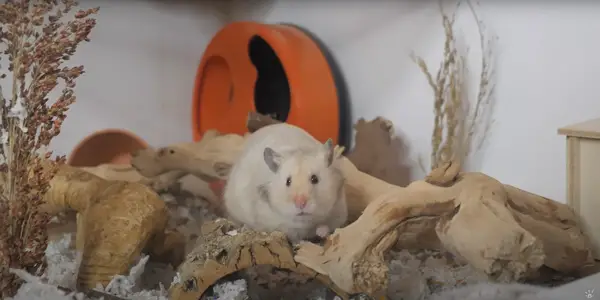Hamsters never die for no reason; it may not be obvious. But there is always a reason for a hamster’s death. As a result, we’ll look at the many direct and indirect causes of a hamster’s death.
Wondering why my hamster very active then died?
Stress is the main reason for your hamster’s hyperactivity before death. Bizarre behavior could be represented as very active but severe. Stress can also be seen as obsessive behavior. You may think of grumpy noises as excitement. But, it might have been for extreme stress that caused death.
If you’re interested to know the details, spare some minutes go through the whole segment.
So, what’s the dealy? Let’s get into the main segment!
5 Reasons Why Your Hyperactive Hamsters Before Death

When a hamster dies, it normally curls up in a fetal position in one of the cage’s corners. Or even in one of its little homes. From afar, you can see this. When they’re in this pose, they’re almost touching their cage.
I know your hamster’s death was too sudden. So, you want to know what is the average lifespan of a hamster?
Of course, most hamsters are not anticipated to live long. They live with an average lifetime of 18 months to a year. Sometimes it lives up to three years.
Because each animal is distinct, they all feel and exhibit stress in various ways. So keep an eye out for any abnormalities in your hamster’s activity. It will be possible to discover high activity in your hamster early if you recognize such issues.
Let’s look at the cause behind the hamster’s frenzied activity:
Reason 1: Hyperactivity
Even in their cages, stressed hamsters become highly hyperactive. They’ll be continually moving. They sprint on their wheels, attempting to climb their cages. They seem a little more jittery and alert than normal.
All of these signs point to your hamster having a lot of stress and worry. It’s looking for a means to get rid of it. It’s likely that your hamster isn’t living in a stimulating environment.
As a result, hyperactivity will display characteristics of destructiveness, anger, and anxiousness.
Reason 2: Bizarre Behaviors
Every hamster needs an enriching environment to thrive. They must engage in physical, mental, emotional, & social activities. It improves their physical, cognitive, sentimental, and social capacities.
If a hamster is forced to follow a sedentary habit in an uninspiring surroundings. It will strive to reduce tension and release energy in different ways. These “ways” might take the form of strange actions or harmful habits.
Biting its cage is one of the most bizarre behaviors it has. You may believe that this little creature is ecstatic or delighted.
Reason 3: Obsessive Tendencies
Stress may manifest itself in most animals as obsessive and repeated behavior. Scratching and chewing constantly and rotating numerous times are examples of this.
It may clean its own body on a regular basis, for example. Such activity may lead to self-mutilation in severe situations. It makes the hamster more susceptible to absences and illnesses.
Reason 4: Viciousness
In hamsters, stress is one of the most common reasons for aggression. You could believe it’s playing because it can’t speak. Furthermore, anxious hamsters are known to be more reactive than normal.
Perhaps it has bared its teeth or has grown more aggressive in general. This is a significant problem. We suggest that you speak with your veterinarian.
Reason 5: Grumpy Noises
Hamsters are often silent or extremely quiet creatures. These little creatures, on the other hand, make distinct sounds when they are stressed. When hamsters are afraid, they snort, and when they are threatened, they grunt.
They may shout or screech when they are exceedingly anxious. These are quite uncommon for these rodents.
This is why getting to know your hamster’s behavioral pattern is extremely necessary. It aids in the detection of any alterations.
Don’t feed your hamster curly lettuce, beans, or frozen veggies.
Hope this helps to feed your hamster perfect healthy food items.
You are probably wondering do hamsters have a lot of energy before they die?
It depends on the reason for their death. They may enjoy a brief surge of activity before crawling back into their nest.
3 Easy Prevention Methods for Hamsters’ Death

It’s not too late to save your other hamsters. Leave your hamster’s habitat as soon as you detect that they are anxious.
Allow them to unwind for a while. In order to guarantee that your hamster is healthy, see your veterinarian.
Furthermore, it’s important to provide your hamster with the preventive measures. Maintain a calm and collected demeanor. Follow these guidelines to avoid hamster death:
Method 1: Enrich Their Surroundings
When it comes to prepping your hamster’s cage, environmental enrichment is crucial. The rat will be allowed to exercise in an enhanced cage.
It may be able to amuse itself while you are away. It will also assist it in maintaining a healthy weight. Other toys and equipment that boost its cognitive capabilities are recommended.
Method 2: Interactions
To be active, happy, and healthy, hamsters need the care and love of their partners. Your hamster will need to be socialized with the other animals in its cage to enhance it.
Method 3: Appropriate Preventative Medication
Some illnesses may affect hamster behavior to change. As a result, it’s essential to provide your hamster with enough preventative medication.
Ascertain that it has a robust immune system. Remember to see your veterinarian every six months. Ensure that your pet has a well-balanced diet. Disinfect their cage on a regular basis and keep them occupied.
FAQs
What happens when a hamster dies?
If you attempt to pet or touch a dead hamster, it will feel rigid. Their muscles will be tense and their body will feel tougher than normal. Home burial is preferable for your hamster. Be sure to bury it at least three feet deep and away from anything else.
Is the hamster hibernating or dead?
Whether your hamster isn’t moving, keep an eye on it to check if it’s breathing. It might be hibernating. When it’s hibernating, its respiration may drop to as little as one breath every two minutes. So keep an eye on it for more than two minutes.
Why is my hamster limp and lifeless?
Pick up a hamster and attentively inspect his limbs. This is one of the most significant ways to determine the difference between a hamster. Which is hibernating and one that has died. During hibernation, your hamster’s body will seem to be dead. He will remain entirely limp even when handled.
Final Verdict
Hope this answers why the hamster very active then died. If properly cared for, hamsters seldom need to see a vet.
Longevity without regular veterinary visits is excellent, but death is part of existence. Your hamster should be euthanized. If the vet thinks there is nothing further you can do to save him.
Good Luck!
- Can Ducks Eat Mushrooms? [Explained With Facts] - August 17, 2023
- Will Cayenne Pepper Keep Ducks Away? Answered in Detail - August 1, 2023
- Can Geese Eat Bananas? [Properly Answered] - June 27, 2023

